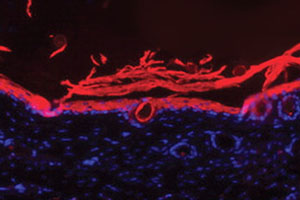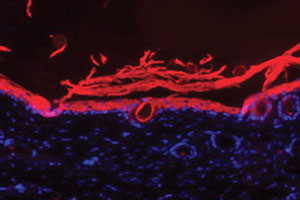
At some point in their lives, 15 percent of people with diabetes will develop a painful and hard-to-treat foot ulcer. Twenty-four percent of those affected will require a lower-leg amputation because of it. And, in some instances, what seems like a harmless sore might even lead to death.
A Northwestern University team has developed a new treatment for this severe and potentially deadly complication of diabetes. Called a “regenerative bandage,” the novel material heals diabetic wounds four times faster than a standard bandage and has the added benefit of promoting healing without side effects.
“Foot ulcers cause many serious problems for diabetic patients,” said Guillermo Ameer, professor of biomedical engineering in Northwestern’s McCormick School of Engineering and surgery in the Feinberg School of Medicine. “Some sores don’t heal fast enough and are prone to infection. We thought that we could use some of our work in biomaterials for medical applications and controlled drug release to help heal those wounds.”
An expert in biomaterials and tissue engineering, Ameer’s research was published online last week in the Journal of Controlled Release. Yunxiao Zhu, a PhD student in Ameer’s laboratory, is the paper’s first author. Northwestern Engineering’s Hao F. Zhang, associate professor of biomedical engineering, and Feinberg’s Robert Galliano, associate professor of surgery, also contributed to the work.
Diabetes can cause nerve damage that leads to numbness in the feet. A diabetic person might experience something as simple as a blister or small scrape that goes unnoticed and untreated because they cannot feel it to know that its there. As high glucose also thickens capillary walls, blood circulation slows, making it more difficult for these wounds to heal. It’s a perfect storm for a small nick to become a life-threatening sore.
Some promising treatments for these chronic wounds exist, but they are costly and can come with significant side effects. One gel, for example, contains a growth factor that has been reported to increase cancer risk with overuse.
“It should not be acceptable for patients who are trying to heal an open sore to have to deal with an increased risk of cancer due to treating the wound,” Ameer said.
Ameer’s laboratory previously created a thermo-responsive material — with intrinsic antioxidant properties to counter inflammation — that is able to deliver therapeutic cells and proteins. His team used this material to slowly release into the wound a protein that hastens the body’s ability to repair itself by recruiting stem cells to the wound and creating new blood vessels to increase blood circulation.
“We incorporated a protein that our body naturally uses to attract repair cells to an injury site,” Ameer said. “When the protein is secreted, progenitor cells or stem cells come to the wound and make blood vessels, which is part of the repair process.”
The thermo-responsive material is applied to the wound bed as a liquid and solidifies into a gel when exposed to body temperature. When the same amount of the protein was directly applied all at once, no benefit was observed. This demonstrates the importance of slow release from the thermo-responsive material. Ameer believes that the inherent antioxidant properties within the material also reduce oxidative stress to help the wound heal.
“The ability of the material to reversibly go from liquid to solid with temperature changes protects the wound,” Ameer said. “Patients have to change the wound dressing often, which can rip off healing tissue and re-injure the site. Our material conforms to the shape and dimensions of the wound and can be rinsed off with cooled saline, if needed. This material characteristic can protect the regenerating tissue during dressing changes.”
In collaboration with Zhang, Ameer imaged diabetic wounds to discover that they were much healthier after application of the regenerative bandage. The blood flow to the wound was significantly higher than in those without Ameer’s bandage.
“The repair process is impaired in people with diabetes,” Ameer said. “By mimicking the repair process that happens in a healthy body, we have demonstrated a promising new way to treat diabetic wounds.”
###
Media Contact
Megan Fellman
[email protected]
847-491-3115
@northwesternu
http://www.northwestern.edu
The post Regenerative bandage heals diabetic wounds faster appeared first on Scienmag.





